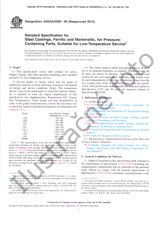Potrebujeme váš súhlas na využitie jednotlivých dát, aby sa vám okrem iného mohli ukazovať informácie týkajúce sa vašich záujmov. Súhlas udelíte kliknutím na tlačidlo „OK“.
ASTM D6780/D6780M-19
Standard Test Methods for Water Content and Density of Soil In situ by Time Domain Reflectometry (TDR)
NORMA vydaná dňa 1.8.2019
Informácie o norme:
Označenie normy: ASTM D6780/D6780M-19
Dátum vydania normy: 1.8.2019
Kód tovaru: NS-970843
Počet strán: 17
Približná hmotnosť: 51 g (0.11 libier)
Krajina: Americká technická norma
Kategória: Technické normy ASTM
Kategórie - podobné normy:
Anotácia textu normy ASTM D6780/D6780M-19 :
Keywords:
compaction test, construction control, density, dielectric constant, electrical permittivity, electromagnetic waves, field control, field tests, inspection, moisture content, quality control, soil compaction, soil density, time domain reflectometry, water content,, ICS Number Code 13.080.20 (Physical properties of soil)
Doplňujúce informácie
| Significance and Use | ||||||||||||||||||
|
5.1 This test method can be used to determine the density and water content of naturally occurring soils and of soils placed during the construction of earth embankments, road fills, and structural backfills. 5.2 Time domain reflectometry (TDR) measures the apparent dielectric constant (Procedure A) and the apparent dielectric constant, first voltage drop and long term voltage (5.3 Soil and pore water characteristics are accounted for in Procedure A with two calibration constants and for Procedure B with five calibration constants. The two soil constants for Procedure A are determined for a given soil by performing compaction tests in a special mold as described in Annex A2. The five soil constants for Procedure B are determined in conjunction with compaction testing in accordance with specified compaction procedures, for example, Test Method D698 as described in Annex A3. Both Procedures A and B use Test Method D2216 to determine the water contents. 5.4 When following Procedure A, the water content is the average value over the length of the cylindrical mold and the density is the average value over the length of the multiple-rod probe embedded in the soil. When following Procedure B, the water content and density is the average values over the length of the multiple-rod embedded in the soil. Note 1: The quality of the result produced by this standard is
dependent on the competence of the personnel performing it, and the
suitability of the equipment and facilities used. Agencies that
meet the criteria of Practice D3740 are generally considered capable of
competent and objective testing/sampling/inspection/etc. Users of
this standard are cautioned that compliance with Practice
D3740 does not in itself
assure reliable results. Reliable results depend on many factors;
Practice D3740 provides a
means of evaluating some of those factors.
|
||||||||||||||||||
| 1. Scope | ||||||||||||||||||
|
1.1 This test method may be used to determine the water content of soils and the density of soils in place using Time Domain Reflectometry. 1.2 This test method applies to soils that have 30 % or less by weight of their particles retained on the 19.0-mm [3/4-in.] sieve. 1.3 This test method is suitable for use as a means of acceptance for compacted fill or embankments. 1.4 This test method is not appropriate for frozen soils or soils at temperatures over 40°C [100°F] and may not be suitable for organic soils, highly plastic soils, or extremely dense soils. 1.5 All observed and calculated values shall conform to the guidelines for significant digits and rounding established in Practice D6026. 1.5.1 The method used to specify how data are collected, calculated, or recorded in this standard is not directly related to the accuracy to which the data can be applied in design or other uses, or both. How one applies the results obtained using this standard is beyond its scope.2 1.6 Two alternative procedures are provided to determine the water content and the density of soil in situ: 1.6.1 Procedure A involves two tests in the field, an in situ test and a test in a mold containing material excavated from the in situ test location. The apparent dielectric constant is determined in both tests. 1.6.2 Procedure B involves only an in situ test by incorporating the first voltage drop and long term voltage (1.7 Units—The values stated in either SI units or inch-pound units are to be regarded separately as standard. The values stated in each system may not be exact equivalents; therefore, each system shall be used independently of the other. Combining values from the two systems may result in non-conformance with the standard. For additional information consult SI10. 1.8 This standard does not purport to address all of the safety concerns, if any, associated with its use. It is the responsibility of the user of this standard to establish appropriate safety, health, and environmental practices and determine the applicability of regulatory limitations prior to use. 1.9 This international standard was developed in accordance with internationally recognized principles on standardization established in the Decision on Principles for the Development of International Standards, Guides and Recommendations issued by the World Trade Organization Technical Barriers to Trade (TBT) Committee. |
||||||||||||||||||
| 2. Referenced Documents | ||||||||||||||||||
|




 Cookies
Cookies
